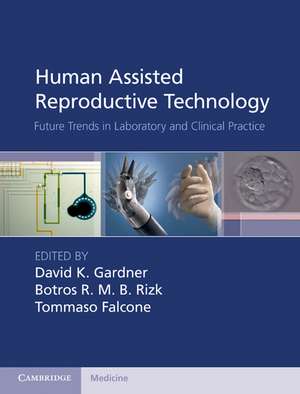Human Assisted Reproductive Technology: Future Trends in Laboratory and Clinical Practice
Editat de David K. Gardner, Botros R. M. B. Rizk, Tommaso Falconeen Limba Engleză Hardback – 30 mar 2011
Preț: 574.74 lei
Preț vechi: 604.99 lei
-5% Nou
Puncte Express: 862
Preț estimativ în valută:
109.97€ • 115.13$ • 90.100£
109.97€ • 115.13$ • 90.100£
Carte indisponibilă temporar
Doresc să fiu notificat când acest titlu va fi disponibil:
Se trimite...
Preluare comenzi: 021 569.72.76
Specificații
ISBN-13: 9781107001121
ISBN-10: 1107001129
Pagini: 250
Ilustrații: 72 b/w illus. 23 colour illus. 53 tables
Dimensiuni: 195 x 253 x 21 mm
Greutate: 0.93 kg
Editura: Cambridge University Press
Colecția Cambridge University Press
Locul publicării:New York, United States
ISBN-10: 1107001129
Pagini: 250
Ilustrații: 72 b/w illus. 23 colour illus. 53 tables
Dimensiuni: 195 x 253 x 21 mm
Greutate: 0.93 kg
Editura: Cambridge University Press
Colecția Cambridge University Press
Locul publicării:New York, United States
Cuprins
1. Use of robotics in reproductive surgery Michelle Catenacci, Carrie Bedient and Tommaso Falcone; 2. Removal of hydrosalpinges and uterine leiomyoma to improve IVF outcome Eric S. Surrey; 3. Ovarian endometriomas: effect on IVF outcome Gabriel de la Fuente and Juan A. Garcia-Velasco; 4. Impact of uterine cavity abnormalities on IVF and pretreatment cavity evaluation Steven F. Palter; 5. Sperm retrieval techniques Sandro C. Esteves and Ashok Agarwal; 6. New concepts in ovarian stimulation Ying Cheong, Nick Brook and Nick Macklon; 7. GnRH antagonists in ART Efstratios M. Kolibianakis and Georg Griesinger; 8. Pharmacogenetics of ovarian stimulation in the 21st century Valeria Pugni and Manuela Simoni; 9. Non-invasive diagnosis of endometriosis with proteomics technologies Lewis K. Pannell, Ashley R. Mott and Christopher B. Rizk; 10. Antiangiogenic agents for endometriosis Edurne Novella-Maestre, Carlos Simón, Juan Antonio García-Velasco and Antonio Pellicer; 11. New concepts in the management of polycystic ovary syndrome Roy Homburg; 12. Adjuvant therapy to increase implantation rates David Meldrum; 13. Ovarian hyperstimulation syndrome Botros R. M. B. Rizk; 14. The evidence-based practice of assisted reproduction Hassan N. Sallam; 15. Three-dimensional in vitro ovarian follicle culture Eugene Galdones, Lonnie D. Shea and Teresa K. Woodruff; 16. Artificial gametes Jan Tesarik and Raquel Mendoza Tesarik; 17. Current status and future trends of the clinical practice of human oocyte in vitro maturation Robert B. Gilchrist, Johan E. J. Smitz and Jeremy G. Thompson; 18. Oocyte and zona imaging David L. Keefe; 19. Granulosa cells and their impact on human ART Laurie J. McKenzie; 20. Sperm diagnosis: selecting the best sperm for IVF/ICSI treatment Denny Sakkas; 21. Embryo culture in the 21st century Mark T. Johnson and David K. Gardner; 22. Morphometric analyzes of embryos Jennifer Kahn, Thomas Elliott and Zsolt Peter Nagy; 23. Embryo biopsy: towards trophectoderm isolation and blastocyst analysis William B. Schoolcraft and Jeanine Cieslak Janzen; 24. Analysis of the embryonic transcriptome Claude Robert, Andrew J. Watson and Marc-Andre Sirard; 25. Analysis of embryo-derived factors as markers of developmental potential and viability Chris O'Neill; 26. Proteomics analysis of the endometrium and embryo: can we improve IVF outcome? Francisco Domínguez, Tamara Garrido and Carlos Simón; 27. Analysis of embryo metabolism and the metabolome to identify the most viable embryo within a cohort David K. Gardner; 28. Oocyte and embryo cryopreservation T. Mukaida; Index.
Recenzii
'… educational, well written and comprehensive …' Acta Obstetricia et Gynecologica Scandinavica
Descriere
Collection of practical articles on cutting-edge topics, reviewing clinical information and looking ahead to practice over the next five years.
